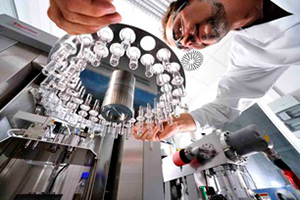30.11.16 | Matthias Birkicht, a chemical engineer at the Leibniz Centre for Tropical Marine Research (ZMT), together with his team has developed a high-performance prototype of a photometer for water analysis. The building instructions and software are largely based on freely available open-source applications from the Internet. In order to be able to offer the device online as an inexpensive alternative, the ZMT is currently looking for partners and sponsors in the field of water analysis, environmental research and development cooperation.
If you would like to know if you can use water from a newly installed well in Africa or Asia or if you are doing research in the field of environmental protection, you will soon be faced with fundamental challenges. Precise photometers are required to provide an accurate analysis of water quality, but these are often expensive, difficult to transport, and complicated with respect to data collection and transmission. That is why it is usually necessary to rely on external laboratories. This involves long waiting times, high costs and the environmentally harmful use of toxic chemicals to preserve samples. “Our decades of research with partners from the tropics have shown us how difficult and challenging water analyses really are,” said Matthias Birkicht. “But I think that with the support of the global open source community we have been able to develop a very promising prototype that addresses these issues.”
The open source and open access community, which the ZMT is committed to as a non-profit organisation, provides knowledge on the Internet free of charge for the benefit of all, including e.g. scientific publications or even software and blueprints for photometers. Those interested can use this information freely or develop it further. Matthias Birkicht thus collected initial ideas for the photometer and built a prototype in his spare time. In recent months he has been able to develop the device further and test it at the ZMT. “During this time we have made remarkable progress. Initial measurements motivated us to go ahead with the project. Already now we can very accurately determine individual parameters at minimal cost. Soon we will also be able to link these data to GPS coordinates and go online with the device. However, we still need more practical support,” Birkicht said.
The goal of the ZMT is now to gain partners or sponsors for the project. “If we are successful in getting support for what I consider to be a good thing, we can soon offer a finished device that every Internet user cannot only make and use for water analyses, but also develop further as desired,” Birkicht added. If you are interested in becoming a partner and sponsor to actively support the project, please contact the ZMT Office for Knowledge Exchange.

 Contacts
Contacts
Dipl.-Ing. Matthias Birkicht
+49 (0)421 23800 - 34This email address is being protected from spambots. You need JavaScript enabled to view it.




